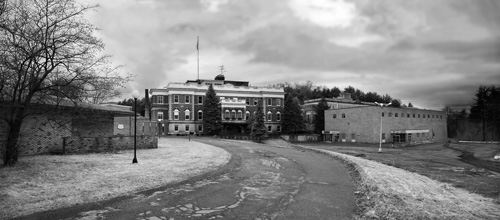News February-March 2015
Former hospital, future resort?
Developer’s plans draw praise, skepticism
 By EVAN LAWRENCE
By EVAN LAWRENCE
Contributing writer
CAMBRIDGE, N.Y.
A developer has proposed turning the former Mary McClellan Hospital complex in Cambridge, N.Y., into a world-class resort. The hospital, seen here in 2010, was once the largest employer in southern Washington County but has been vacant since 2003. Sean McEntee file photo
When a developer came forward late last year and proposed converting the derelict Mary McClellan Hospital property into a world-class resort, local officials in southern Washington County responded enthusiastically to what they predicted would be a huge economic boon to the region.
But since then some have begun to raise concerns about the project’s potential impact on the community -- and about whether the developer can make good on his plans.
“The project has a tremendous amount of potential, but we have to thoroughly review it,” Cambridge Mayor Valerie Reagan said. “We need to know a lot more about it.”
The hospital property, on a hill on the west side of the village, comprises 122 acres, mostly within the village limits, and 11 buildings. It offers sweeping views of the Cambridge valley and the Green Mountains to the east.
The hospital was a gift to the community in 1918 from Edwin McClellan, a Washington County native who named it in honor of his mother. Over the years, the hospital grew with the community, adding wings, support buildings and a nursing home.
At one time, Mary McClellan Hospital was the largest employer in southern Washington County and a major part of the local economy. But as health care and its financing changed, the hospital couldn’t keep up. It closed in 2003.
In 2006, a new owner opened an adult home in the former nursing home and planned to convert the main building into apartments for seniors. But that endeavor failed, shutting down in early 2008, and the property wound up in foreclosure.
In 2010, a Virginia couple with ties to the area, Frank and Nicole Klebieko, bought the entire complex for $300,000. Efforts to reach the Klebiekos for comment for this story were unsuccessful, but at the time they acquired the property, they said they hoped to reopen it for uses that would benefit the area, such as medical facilities, a school or offices. No specific plans ever materialized, however.
The Klebiekos were unable to maintain the buildings, which were already deteriorating. Vandals broke in and stole the copper plumbing for scrap. The roofs began to leak, and weeds sprang up in the broken parking lots. The property is now listed online for $599,000.
Unveiling a grand plan
In November, developer Gideon Raviv, a native of Israel, announced that he had the property under contract and wanted to turn it into a resort. His closing is contingent on receiving approval from the village Planning Board.
A public hearing on Dec. 10 drew more than 40 people, despite the heaviest snowfall of the month. Plans displayed at the hearing described the project as “The Cambridge Club Inn, a proposed hospitality resort living environment.”
The first phase of Raviv’s proposal would construct a new, one-story building with dining facilities, meeting rooms, and spa facilities on what is now a parking lot. Phase 2 would convert some of the existing buildings into a hotel with about 200 rooms. In Phase 3, up to 70 rental homes would be built in the woods around the main complex.
Eddie Esposito of Monarch Design LLC of Halfmoon, who joined Raviv to present the project to the Planning Board, said if the plans were approved immediately, construction could begin in the spring. The support building and 25 guest rooms in the former nursing home could be open by the end of the year. The entire project would take about six years, he said.
Raviv said he wanted to “invite people from all over the world,” including those who might otherwise go to the Berkshires, Vermont or Saratoga Springs. However, he acknowledged he hadn’t done a marketing plan to test the feasibility of his proposal.
Some in the crowd that turned out for the hearing raised questions about the project and Raviv’s ability to carry it out, especially given the decrepit condition of the buildings.
Raviv estimated that it would cost more than $10 million to redevelop the property, but he wouldn’t disclose where he would get the money, saying that wasn’t relevant.
Skeptics questioned why Raviv thought anyone would come to the resort as well as how the project would affect local services, utilities, traffic and the environment -- and how it would be integrated into the community.
Some pointed out that Raviv and his business, 68 Burns Development Inc. of Forest Hills, has completed no other projects in the United States. Raviv responded by saying he had opened Israel’s first school for waiters and chefs and is building a community in Israel for active adults over age 55.
The Planning Board balked at Raviv’s request for a “blanket conceptual approval” for the entire project. The board also disagreed with the rural residential zoning designation that Raviv wanted, saying that a planned development district would be more appropriate. The meeting ended with no action.
Seeking expert advice
In early January, Raviv resubmitted his application with just Phases 1 and 2, along with a state-required environmental impact assessment. At its Jan. 10 meeting, the Planning Board reviewed the documents, raising questions and pointing out some places where the documents were incomplete. The board decided to seek expert guidance before it went any further.
The next week, village trustees approved hiring consultants to help with the review process.
“I called the Saratoga County planning board for advice,” Reagan said.
The Cambridge board agreed to hire The Chazen Companies, a consulting firm with an office in Glens Falls that the village has used before for zoning issues, and The Jones Firm, a law office in Saratoga Springs.
“The consultants will make recommendations from zoning and legal perspectives,” Reagan said.
She said the village will ask Raviv to pay into an escrow account to cover the consultants’ fees, which are estimated to be at least $10,000.
“If he says yes, we proceed with the review,” Reagan said. “If he says no, that’s the end of it.”
Richard Sweeney, the Planning Board chairman, agreed that the project can’t go forward unless the developer is willing to pay for the consultants’ fees.
“If Raviv doesn’t want to pay, the project is dead,” Sweeney said. “It’s in his hands right now.”
Raviv didn’t want to discuss the project when contacted but indicated he was displeased that the village was seeking outside guidance.
“I want to feel comfortable with the village board first,” Raviv said. “Let the lawyers finish the job.”
‘A plus to our community’
Cambridge Supervisor Cassie Fedler said officials from her town had attended the public hearing, although only about 20 acres of the project’s last phase would be in the town outside the village line. The town has a Planning Board that mostly reviews subdivision proposals; it lacks site-plan review or zoning regulations.
“Everything is out of our hands,” Fedler said. “We’re just watching things go now.”
Fedler said the project offers “potential for jobs, tourism, and sales tax money,” but acknowledged that “people are concerned about change.”
“It would be lots of revenue to southern Washington County if it happens,” she said.
The town of White Creek is east of the hospital property and includes about two-thirds of the village.
“I’ve had a lot of phone calls -- ‘Is this too good to be true?’ ” White Creek Supervisor Robert Shay said, adding that some townspeople are “doubting Thomases.”
“I would have to think the developer has done his homework,” Shay said. “It’s still a plus to our community even if he does only half of it. We’re all going to benefit regardless of which town it’s in.”
Sarah Ashton, president of the Cambridge Valley Community Development and Preservation Partnership, suggested the developer would do well to work cooperatively with local planning officials and be receptive to citizens’ concerns. Her organization oversaw the redevelopment of the village’s former railroad freight yard complex from 2004 to 2011.
“Process is important,” Ashton said. “The Freight Yard Project was more successful with input from the community and by working with the village Planning Board.”
Deteriorating fast
Esposito did design work for the adult home operator that attempted to redevelop the hospital complex 10 years ago, so he is familiar with the site. He warned that whatever the Planning Board decides, time is running out for the buildings.
Florence Nightingale Hall, a former nursing school at the top of the hill, “is pretty much all done,” Esposito said.
He ticked off a list of problems in the other buildings: mold and mildew, fallen plaster and woodwork, cracked terrazzo flooring, rusting structural members, asbestos, vandalism, and stolen plumbing.
“It needs a lot more money than it did two years ago,” Esposito said. “It won’t be pretty or inexpensive if they wait any longer.”
Reagan said she still hopes Raviv can make his plan a reality.
“I’m hopeful that he hangs in there so we can get more information,” Reagan said. “If people were to come here and we could draw them to the village and countryside, that would be wonderful.”
Reagan said lots of other good things are happening in the Cambridge area, including progress on converting the former Cambridge Hotel into an assisted-living residence, sale of the Old Union School building to a company that plans to create a high-tech research lab and factory, more activity at Hubbard Hall, expansion of the Morcon paper plant south of the village, and the demolition, after years of negotiations, of an abandoned building on West Main Street.
“It’s exciting that we even have this to talk about,” she said of the hospital redevelopment.

